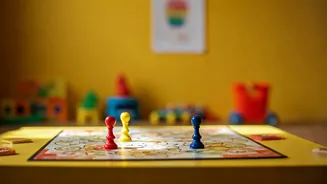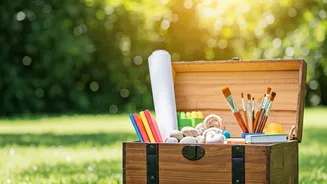Embrace Curiosity Together
The first habit involves nurturing a sense of wonder in children. Parents should actively participate in exploring the world alongside their kids. It means
encouraging questions and embracing their natural curiosity, showing genuine excitement in the face of their child's inquiries. This might involve exploring topics they're interested in, such as dinosaurs or outer space. It's about being a learner alongside your child, showing them that it's okay not to know everything and that the process of finding answers is enjoyable. Make learning a shared experience by reading together, visiting museums, or simply asking "what if?" questions. This co-exploration helps kids view learning as a collaborative, exciting endeavor.
Make Reading a Habit
Next is the development of a strong reading culture. Reading isn't just about textbooks; it’s about books of all kinds: fiction, nonfiction, comics, and magazines. Encourage regular reading by setting aside dedicated reading time as a family. Moreover, allow children to pick their books. This enables them to explore their interests. Visit the library or a bookstore frequently, making it a fun outing. Model reading yourself. When children see their parents enjoying books, they're more likely to see reading as a valuable and pleasurable activity. Discussing books, characters, and ideas extends the learning and demonstrates that reading can be a gateway to different worlds and exciting adventures.
Value Mistakes as Growth
The third important habit is changing the way children view mistakes. Rather than punishing errors, view them as learning opportunities. This creates a safe space for experimentation and learning. Parents should emphasize the effort and process of learning over the outcome. Praise a child's perseverance when faced with a challenging problem. This approach helps them develop resilience and a growth mindset, where they see their abilities as something that can be developed through dedication and learning. Instead of saying, “You failed,” try, “Let's try a different approach.” This fosters a positive relationship with failure, encouraging children to take risks and learn from their experiences.
Encourage Exploration, Play
Make room for play and exploration. Structured play allows kids to experiment with ideas, problem-solve, and develop essential skills, and helps make them comfortable with exploration and learning. Provide opportunities for creative expression through art supplies, building blocks, or musical instruments. This promotes problem-solving abilities and enhances critical thinking skills. Set up activities that require them to think outside the box. This includes games, puzzles, or creative writing prompts. This also reinforces the idea that learning can be an engaging and enjoyable process. It’s also crucial to offer time for unstructured play, where children can guide their learning and use their imagination.
Emphasize Real-World Learning
Connect learning to the real world. Help children see how what they learn in the classroom or at home applies to their daily lives. Take them to the local market and discuss math by estimating the cost of groceries. If they're studying history, visit historical sites and discuss those events. Watch documentaries about topics they're curious about. Such real-world connections make learning relevant and engaging. This demonstrates how knowledge empowers them to interact with and understand the world around them. Support children's interests by finding resources that let them learn more about those areas. This reinforces that learning is not limited to school and can be an exciting journey.





